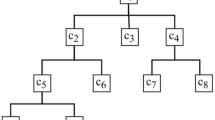Abstract
On the basis of psychological studies about similarity, we propose a model, called the fuzzy contrast model, to measure the semantic similarity between concepts expressed by OWL DL. By transforming an OWL DL concept to a set of axioms in description logic \(\mathcal {S}\mathcal {H}\mathcal {O}\mathcal {I}\mathcal {N}(\mathcal {D})\), the fuzzy contrast model computes the similarity of concepts from their semantic descriptions in \(\mathcal {S}\mathcal {H}\mathcal {O}\mathcal {I}\mathcal {N}(\mathcal {D})\). In order to imitate human perception of sameness and difference, fuzzy set is introduced to built intersection and set difference of feature set in our model. An iterative method is proposed to compute the similarity of concepts. Two experimental results are provided to show the effectiveness of fuzzy contrast model.
Preview
Unable to display preview. Download preview PDF.
Similar content being viewed by others
References
Wu, Z., Palmer, M.: Verb Semantics and Lexical Selection. In: Proceedings of 32nd Annual Meeting of Association for Computational Linguistics, Las Cruces, New Mexico, pp. 133–138 (1994)
Song, J., Zhang, W., Xiao, W., et al.: Ontology-based Information Retrieval Model for the Semantic Web. In: Proceedings of 2005 IEEE International Conference on e-Technology, e-Commerce and e-Service, Hong Kong, China, pp. 152–155 (2005)
Resnik, P.: Using Information Content to Evaluate Semantic Similarity in a Taxonomy. In: Proceedings of the 14th International Joint Conference on Artificial Intelligence, pp. 448–453. Morgan Kaufmann, San Francisco (1995)
Church, K.W., Hanks, P.: Word Association Norms, Mutual Information, and Lexicography. In: Proceedings of the 27th Annual Meeting of the Association for Computational Linguistics, Vancouver, B.C., pp. 76–83 (1989)
Lesk, M.: Automatic Sense Disambiguation using Machine Readable Dictionaries: How to Tell a Pine Cone from an Ice Cream Cone. In: Proceedings of the 5th Annual International Conference on Systems Documentation, Toronto, Canada, pp. 24–26 (1986)
Santini, S., Jain, R.: Similarity Measures. IEEE Transactions on Pattern Analysis and Machine Intelligence 21(9), 871–883 (1999)
Attneave, F.: Dimensions of Similarity. American Journal of Psychology 63, 516–556 (1950)
Ashby, F.G., Perrin, N.A.: Toward a Unified Theory of Similarity and Recognition. Psychological Review 95(1), 124–150 (1988)
Rosh, E.: Cognitive Reference Points. Cognitive Psychology 7, 532–547 (1975)
Rothkopf, E.Z.: A Measure of Stimulus Similarity and Errors in Some Paired-Associate Learning Tasks. Journal of Experimental Psychology 53, 4–101 (1957)
Tversky, A.: Features of Similarity. Psychological Review 84(4), 327–352 (1977)
Tversky, A., Gati, I.: Studies of Similarity. In: Rosch, E., Lloyd, B.B. (eds.) Cognition and Categorization, pp. 79–98. Lawrence Eribaum Associates, New York (1978)
Rodriguez, A.M., Egenhofer, J.M.: Determining Semantic Similarity among Entity Classes from Different Ontologies. IEEE Transactions on Knowledge and Data Engineering 15(2), 442–456 (2003)
Horrocks, I., Patel-Schneider, P.F.: Reducing OWL Entailment to Description Logic Satisfiability. In: Proceedings of the 2003 International Semantic Web Conference, Berlin, German, pp. 17–29 (2003)
Baader, F., McGuinness, D.L., Nardi, D., et al. (eds.): The Description Logic Handbook: Theory, Implementation and Applications. Cambridge University Press, Cambridge (2002)
Author information
Authors and Affiliations
Editor information
Editors and Affiliations
Rights and permissions
Copyright information
© 2006 Springer-Verlag Berlin Heidelberg
About this paper
Cite this paper
Qiu, M., Chen, G., Dong, J. (2006). A Fuzzy Contrast Model to Measure Semantic Similarity Between OWL DL Concepts. In: Wang, L., Jiao, L., Shi, G., Li, X., Liu, J. (eds) Fuzzy Systems and Knowledge Discovery. FSKD 2006. Lecture Notes in Computer Science(), vol 4223. Springer, Berlin, Heidelberg. https://doi.org/10.1007/11881599_119
Download citation
DOI: https://doi.org/10.1007/11881599_119
Publisher Name: Springer, Berlin, Heidelberg
Print ISBN: 978-3-540-45916-3
Online ISBN: 978-3-540-45917-0
eBook Packages: Computer ScienceComputer Science (R0)




